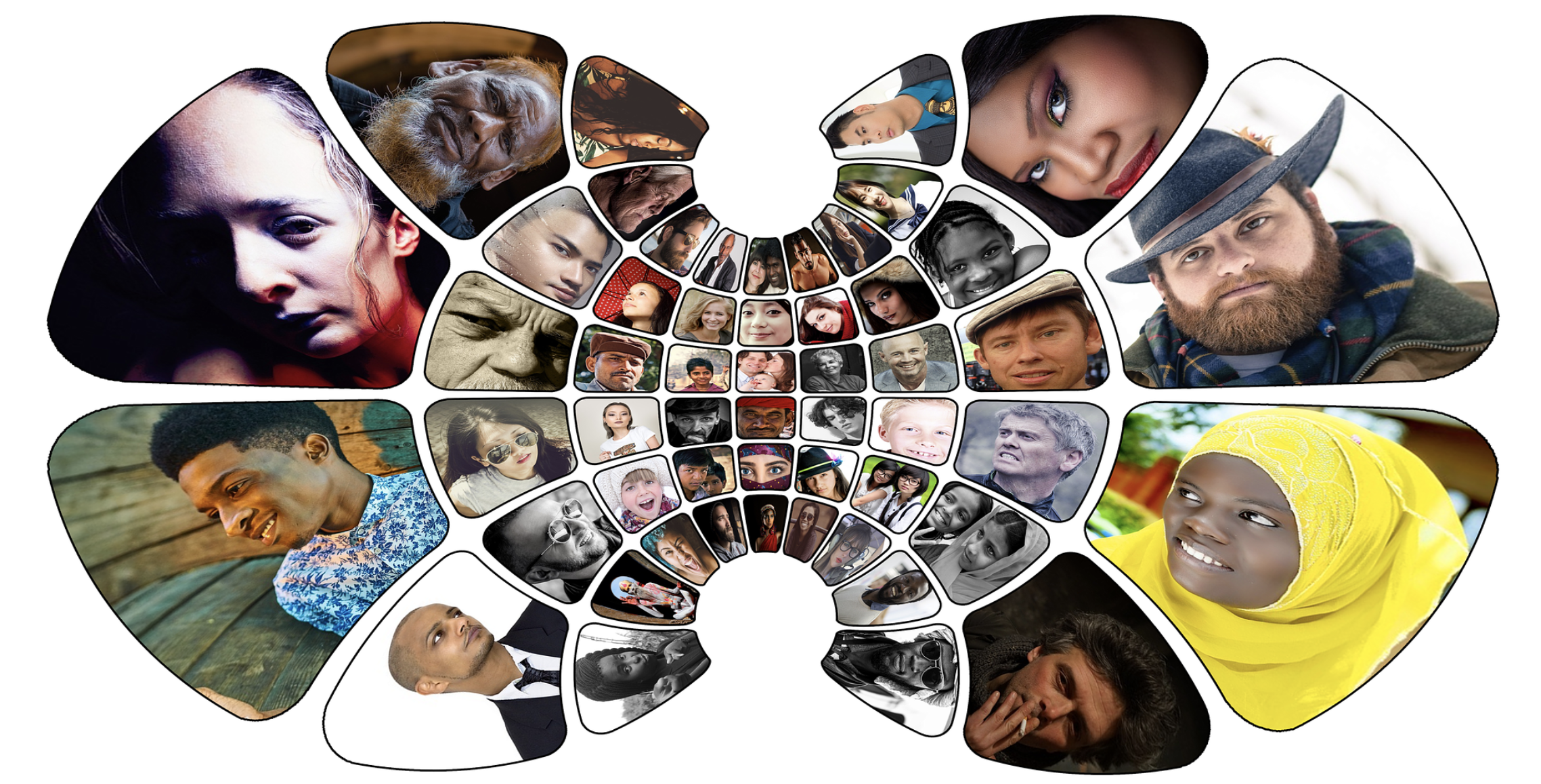1.1: Introductory Lesson- An overview of sociolinguistics
- Page ID
- 122083
A short introduction to basic concepts of Sociolinguistics, and the role of prescriptive organizations like the Real Academia Española.
An overview of sociolinguistics
Kelley León Howarth and Claudia Holguín Mendoza | University of Oregon

Sociolinguistics is the scientific study of language and society.
According to the Linguistics Society of America,
Language is one of the most powerful emblems of social behavior. In the normal transfer of information through language, we use language to send vital social messages about who we are, where we come from, and who we associate with. It is often shocking to realize how extensively we may judge a person's background, character, and intentions based simply upon the person's language, dialect, or, in some instances, even the choice of a single word. Given the social role of language, it stands to reason that one strand of language study should concentrate on the role of language in society. Sociolinguistics has become an increasingly important and popular field of study, as certain cultures around the world expand their communication base and intergroup and interpersonal relations take on escalating significance.
Step 1
With a partner, read the following quotes about language and decide if they are valid or not (for you).
Have you heard these ideas before? Which of them are myths in society?
|
Valid or not? |
Step 2 |
||
|---|---|---|---|
|
1. |
“News broadcasters on TV and Internet do not have accents.” |
||
|
2. |
“Johana is not doing well in Math because her dad speaks to her in Spanish and her mom speaks to her in English.” |
||
|
3. |
“Chinese is more difficult to learn than French.” |
||
|
4. |
“English and Spanish are more developed languages than Zapotec and Mixtec because the former have more literary production than the latter.” |
||
|
5. |
“Miriam, like many professional women, is frustrated because her coworkers Paul and John do not let her speak in meetings at work. When she is able to speak, they interrupt her constantly.” |
||
|
6. |
“Daniel is bilingual in Mexican Sign Language and American Sign Language.” |
||
|
7. |
“African American Vernacular English (AAVE) is a valid and correct English variety with its own complex grammatical and pronunciation systems.” |
||
|
8. |
“To say hors d’oeuvre is more elegant than to say appetizer.” |
||
|
9. |
“Young people these days are ruining the English language with their literally and their likes.” |
||
|
10. |
“The phrase ‘nobody wasn’t there’ really means that someone was actually there, because two negatives makes a positive.” |
Step 2
Read the titles of the myths in the article below about language. Then, in pairs or groups, for each sentence from the table, write in column “Step 2” which myth from the reading corresponds to the idea expressed.
Burton, Strang, Dechaine, Rose-Marie, and Vatikiotis-Bateson (2012). Ten myths about language busted by linguists, in Linguistics for Dummies, John Wiley & Sons, pp. 323-329 (Unit 19).
Step 3
1. Consider the following English words. Can you associate them with the words in the chart? Write them in the column at the right.
AVOCADO, CHOCOLATE, CASTLE, COFFEE, CASSEROLE, POTATO, PRETZEL, COYOTE
|
ENGLISH |
|||||
|
XOCOLATL |
|||||
|
BREZE(L) |
|||||
|
AGUACATE |
|||||
|
CASSEROLE |
|||||
|
COYOTL |
|||||
|
KAHVEH |
|||||
|
CHATEAU |
|||||
|
PATATA |
2. What languages are contained in this table? Try to label the columns across the top, and complete any squares that you can.
3. Do these terms refer to the same concept in both English and the other language?
4. Which form is the "correct"/“original” spelling of these words? How does the idea of linguistic purity relate to the information in this table? Who invented this manner of representing this language (this orthography, spelling in each language)?
This language codification has invisibilized indigenous communities. Phonetic and phonological pronunciations from varieties of Náhuatl or other indigenous varieties are lost through the normalized and unquestioned use of the Spanish graphemes. This exercise has the potential of deconstructing language codification in many contexts more depending on students comments and other examples the instructor may find useful to include.
For more information, consult http://www.ancientscripts.com/aztec.html to see how the European (Spanish) approach to written representations of language differs from the indigenous writing system.
References
Kalmar, Tomás Mario (2015) Illegal Alphabets and Adult Biliteracy: Latino Migrants Crossing the Linguistic Border, second edition. Routledge.
Mar-Molinero, Clare (2000) The Politics of Language in the Spanish-speaking World. Routledge.
Step 4
Now, let’s watch the following video.
https://www.youtube.com/watch?v=FlwvtOEHPSg
Questions to discuss in class:
1. Who is behind the production of this advertisement?
2. What is the main purpose of this advertisement?
https://www.youtube.com/watch?v=jvnOS6KWEhc
3. Do you believe that this propaganda will ultimately be successful? Is this campaign going to stop the use of English borrowings in Spanish? Why or why not?

Decolonized Lexicon
Spanish Heritage Language Program
Department of Romance Languages, University of Oregon
Thank you to the UO Spanish Heritage Language Team for all the work of creating this Decolonized Lexicon, especially to Amy Costales and Kelley León Howarth, who started the list for SPAN 308 Comunidades bilingües.
Step 1
1. Read the following definition from Wikipedia.
is the establishment of a colony in one territory by a political power from another territory, and the subsequent maintenance, expansion, and exploitation of that colony. Colonialism involves unequal relationships between the colonial power and the colony and often between the colonists and the indigenous peoples. (https://en.Wikipedia.org/wiki/Colonialism)
Then, working with two or three partners, make a semantic map based on the term “colonial”. What associations do you have with this term?

2. Compare your group’s map with the others in the class. What elements do they have in common?
3. What effect might colonialism have on language? How might the power relations mentioned in questions 1 and 2 above be encoded in language? Brainstorm with your group a list of possibilities.
4. Now read the introduction to the Decolonized Lexicon (below) to see if your ideas from number 3 above appear in this text.
Text by Robert L. Davis, translation and adaptation by Kelley León Howarth
European colonization (XV-XX centuries) imposed linguistic (languages), cultural and political systems in different parts of the world that displaced existing systems in the colonized places. Decolonization, then, refers to the process of re-centering the points of linguistic, cultural and political reference from the Eurocentric to the perspective and the realities of the people who live in places that experienced colonization.
One simple example of linguistic decolonization is the substitution of the term Asian for Oriental to refer to inhabitants of Asia. This continent is to the east of Europe, and the adjective oriental (“eastern”) encodes a European point of view about these populations and regions. The term Oriental has acquired certain connotation about stereotypical and limited representations of the cultures of these regions on the part of intellectuals and artists of the “West” (Europe or North America). Asian, by contrast, is more neutral in that it only indicates geographic origin. For a Japanese, Chinese or Vietnamese person, their continent of origin does not require a reference to the European point of view.
These type of substitutions are not a linguistic game or “political correctness.” The use of decolonized terms reflects an awareness about the history of colonialism, and expresses a posture of equality and respect toward languages, populations and cultures from different parts of the world.
In the list that follows, we present a series of options for terms that, as educators, we have observed are charged with prejudices and ideologies. Many of these items have already been signaled before in literature; others we have learned through the professional circles of those who share an interest in creating more awareness about our use of language and its effects on speakers. Some of the other terms we have coined in our teaching practice in the classroom and through the contributions of the students themselves.
In the second column we offer proposals for decolonized terminology, alternatives to the terms in the first column that can carry a negative ideological charge. In the third column we offer some possible explanations for the “semantic baggage” associated with the terms in the first column.
Step 2
1. Scan the list of terms in columns 1 and 2 in this lexicon. Which pairs have you heard, used, or considered not using? Before you read the explanations in the third column, jot down your reasons, then compare your answers with the text in the “Why?” column below.
2. Which terms are new to you? Read the explanations in the “Why?” column and discuss with a partner your reactions to the perspectives described.
3. What other concepts/terms would you add and why?
|
Term charged with prejudice |
Decolonized Term |
Why? 
|
|---|---|---|
|
1. "Low(er) class" |
Working class |
The terms "high" and "low" communicate values and prejudices (many times implicit). "Working class" is a more neutral form we can use to refer to a socio-economic group with less access to economic and cultural capital. |
|
2. “Uneducated person" |
Person with a low level of formal education |
1. "Educación/education" is a false cognate between Spanish and English; in some varieties of Spanish, it means "culture" or "manners". We avoid this expression in order to avoid confusion. 2. People who have limited access to attending school know perfectly well how to act in different vital environments. To say that someone “isn’t educated” privileges one type of experience (formal schooling) and the cultural capital that it gives too much; this is epistemic violence\(^1\) that does not recognize all that people know and erases the enriching experiences that they have lived. |
|
3. “Bad” (Spanish/English/etc.) |
Non-privileged varieties of (Spanish/English/etc.) |
Terms like “bad” or “good” transmit a moral judgment about the linguistic forms that do not have a place in a neutral and objective description of a language. This linguistic judgment tends to extend itself unconsciously to the people that use non-privileged varieties, and the direct association between a linguistic form and the person that uses it ("you speak badly, therefore you are bad") can lead to discrimination. |
Step 3
Why does it matter which terms we use? Consider using this quote by Nobel Peace Prize winner Elie Weisel, then discuss the questions that follow with a partner.
You who are so-called illegal aliens must know that no human being is illegal. This is a contradiction in terms. Human beings can be beautiful or more beautiful, they can be fat or skinny, they can be right or wrong, but illegal? How can a human being be illegal?
—Elie Wiesel
1. What real-world impact might using the term “illegal alien” have? Who would be affected, and how?
2. The impact of terminology is a topic that has received much attention in recently. Watch this video on the same theme and jot down any connections you find with the ideas developed in this lesson: https://www.youtube.com/watch?v=VHulvUwgFWo.
More resources
- “Empowering Learners of Spanish” open source units for teaching critical metalinguistic awareness and proficiency in sociopragmatic variation Index
- Center for Open Educational Resources for Language Learning http://www.coerll.utexas.edu/coerll/
- Spanish Heritage Language teacher community from COERLL https://heritagespanish.coerll.utexas.edu/
- From the Vernacular of Privilege, by Lisa Minnick https://www.dailykos.com/stories/2013/10/20/1245767/-The-Vernacular-of-Privilege
- “[An] ideological problem is that a lot of people seem to think that there are only two possible options: inflexible policing of standard-language ideology… or total linguistic anarchy, which is what some of my English-professor colleagues sometimes accuse me of advocating (and they say it like it’s a bad thing).”
- Ofelia Gracía and Translanguaging https://ofeliagarcia.org/
- Literature on how language influences the way we think https://us.macmillan.com/throughthelanguageglass/guydeutscher/9780312610494/
- Inoue, Asao B. (2015) Antiracist Writing Assessment Ecologies: Teaching and Assessing Writing for a Socially Just Future https://wac.colostate.edu/books/inoue/
- Decolonizing Methodologies video https://www.youtube.com/watch?v=rIZXQC27tvg&t=5890s
Questions? Comments? Contact us at:
Kelley León-Howarth khowarth@uoregon.edu
Claudia Holguín Mendoza, cholguin@uoregon.edu
Robert L. Davis, rldavis@uoregon.edu
This work is licensed under a Creative Commons Attribution-NonCommercial-ShareAlike 4.0 International License.

